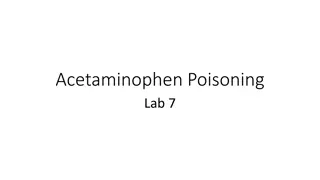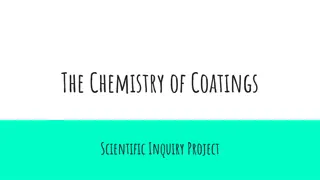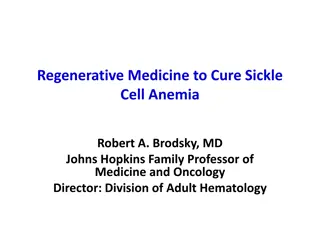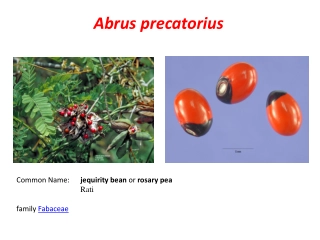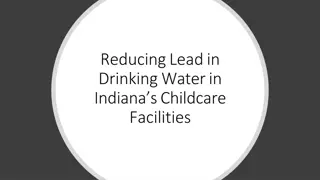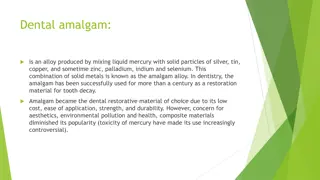
Unmasking the Toxicity of the Film-Forming Finish Paradigm in the Coatings Industry
Exposure to toxic fumes emitted by film-forming finishes during application and drying poses significant health hazards to workers and occupants of coated spaces. Painters, contractors, and DIY enthusiasts are particularly vulnerable to inhaling harmful chemicals, leading to respiratory ailments, headaches, nausea, and dizziness. Prolonged exposure can even increase the risk of more severe conditions like asthma, cancer, and neurological disorders. nn//odiesoil.com/blog/unmasking-the-toxicity-of-the-filmforming-finish-paradigm-in-the-coatings-industry/
Download Presentation
Please find below an Image/Link to download the presentation.
The content on the website is provided AS IS for your information and personal use only. It may not be sold, licensed, or shared on other websites without obtaining consent from the author. Download presentation by click this link. If you encounter any issues during the download, it is possible that the publisher has removed the file from their server.
Presentation Transcript
Unmasking the Toxicity of the Film-Forming Finish Paradigm in the Coatings Industry Introduction: In the world of coatings and finishes, the allure of film-forming finishes has long been undeniable. These coatings, which create nothing more than a weak and temporary protective layer over surfaces and which degrades over time, make promises of durability, aesthetic appeal, performance that simply aren t quite and enhanced true. Beneath the glossy exterior that many film forming finishes provide, lies several troubling realities. This article will focus on just one of them - the toxicity inherent in many film-forming finish formulations. As environmental consciousness and health concerns continue to gain prominence, it's imperative to shed light on the dark side of this paradigm in the coatings industry. The Toxic Cocktail:
Film-forming finishes often contain a cocktail of chemicals, including volatile organic compounds (VOCs), hazardous air pollutants (HAPs), and other harmful additives. Chemical benzene and formaldehyde, are notorious for their adverse contributing to indoor air pollution and posing risks to human health. HAPs, meanwhile, can detrimental effects on both human health and the environment, respiratory issues, neurological disorders, and ecosystem technologies have more recently been applied to mask the odors, lock the volatiles into the compounds for slower release, or simply reduce the aromatics while still maintaining the presence of the offending molecules and compounds. VOCs, such as health effects, have long-term leading to disruption. Some Furthermore, the manufacturing, application, and disposal processes of film- forming finishes contribute to environmental pollution and degradation. From the extraction of raw materials to the release of emissions during manufacturing, application, and curing, the entire lifecycle of these coatings exacts a heavy toll on ecosystems and human well-being. Once a film forming finish is applied to a wood floor, it reduces the lifespan of the floor and increases the chances of that wood floor and its toxin laden finish coating winding up in a landfill and eventually our groundwater. Alternatively, using a natural toxin-free oil finish such as Odie s Oil will assure the floor lasts the life of the building and will not wear down to the tongue and groove via several re- sanding s that puts toxic finish dust powder into the building environment each time. Health Hazards:
Exposure to toxic fumes emitted by film-forming finishes application and drying poses significant health hazards to workers and occupants spaces. contractors, enthusiasts particularly vulnerable to inhaling during of coated Painters, and DIY are harmful chemicals, leading to respiratory ailments, headaches, nausea, and dizziness. Prolonged exposure can even increase the risk of more severe conditions like asthma, cancer, and neurological disorders. Flooring and furniture finishing professionals often struggle with contact dermatitis from skin contact with film forming finishes, particularly polyurethane and hybrid polyurethanes marketed as European hard wax oils. In addition to the dermatitis, absorption through the skin and into the liver and blood stream presents additional health risks and hidden damage, some of which are not manifest until decades after initial exposure. Moreover, once applied, these finishes continue to release VOCs into the indoor environment, contributing to poor indoor air quality and the phenomenon known as "sick building syndrome." Occupants of buildings coated with toxic finishes may experience a range of symptoms, including fatigue, eye irritation, and allergic reactions, impairing their quality of life and productivity. Unfortunately, the paradigm of film forming finishes is prevalent across nearly every colored or protected surface in homes, offices, and institutional buildings. It is a crying shame that the unsuspecting public has permitted giant chemical corporations to dictate the conditions in which we dwell, work, and play. Environmental Impact: Beyond the immediate health concerns, the environmental impact of film-forming finishes cannot Unwholesome VOC chemical solvents formation of ground-level ozone and smog, be emissions contribute overstated. from the to
exacerbating air pollution and exposure risks to living organisms from people to pets and wildlife. Additionally, the disposal of leftover coatings and contaminated waste further burdens landfills and contaminates soil and waterways, perpetuating a cycle of environmental degradation. Sustainable Alternatives: Fortunately, traditional film-forming finishes are emerging, driven by a return to the sanity of antiquity, technological advancements, and awareness of environmental and health concerns. coatings, and hydrocarbons and solvents may reduce aromatic VOC s but still simply mask underlying toxicity. alternatives to a growing Water-based dearomatized the otherwise lternatively, bio-based and natural penetrating oils that are free from part two catalysts and petroleum derived solvents, and which are made from renewable resources such as plant oils and resins, offer a sustainable alternative with minimal to near zero environmental impact. The leading product in this all-important paradigm shift is Odie s Oil made from a mixture of USP (US Pharmacopeia) grade and food grade ingredients, it contains no hydrocarbon solvents, not heavy metal additives, no isocyanates, no plasticizers, and no hardeners, making Odie s Oil the safest and most environmentally sustainable from cradle to grave of all available finishes. The unique molecule that Odie s Oil formulation generates has proven to be far more durable and protective than any wood finish coating ever made, and it has none of the drawbacks associated with film-forming finishes. Dangers of Nano-Coatings The chemical companies continue to struggle with improving their film coating paradigm. The last disaster they have mustered up to drive sales are nanotechnology additives to their toxic chemical formulations. While nano- coatings may provide superior protection to varnish and polyurethane formulations or serve as topcoats to them, they introduce a far more insidious element of risk into the application, use, and waste stream environments. The most popular nanotech being promoted in the coatings industry is graphene
or graphene oxide which is carcinogenic and highly toxic to all life on the planet and threatens to disrupt and contaminate entire food chain and our ground water! These coatings form ultra-thin layers that repel water, oil, and contaminants, but they need to be replenished routinely leaving the users exposed to the toxic nanoparticles as they wear away and as they are replenished. And they are entirely unnecessary since Odie s Oil can provide superior protection without the toxic nanoparticles. For more information and a deeper dive into the dangers of graphene and other nanoparticle enhanced finishes visit our May 1, 2023, blog post entitled Ceramic Coatings & Nano- Graphene the Devil in the Details: Exposing the Lies of Big Chemical Part 7. We will also be coming out with another blog post on this subject soon. The toxicity of the film-forming finish paradigm in the coatings industry underscores the urgent need for a paradigm shift towards safer, more sustainable alternatives. By prioritizing human health and environmental preservation, stakeholders in the coatings industry should embrace the Odie s Oil paradigm that eliminates harm and maximizes performance. Through concerted efforts and collaboration, we can pave the way towards a healthier, more sustainable future where coatings enhance, rather than compromise, our well-being, and the planet we call home. Source: filmforming-finish-paradigm-in-the-coatings-industry/ https://odiesoil.com/blog/unmasking-the-toxicity-of-the-

